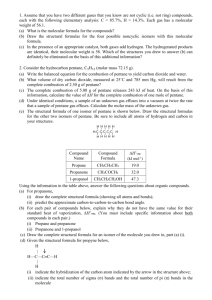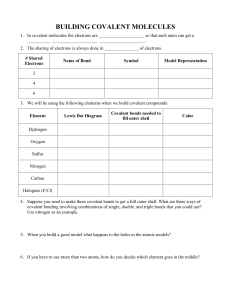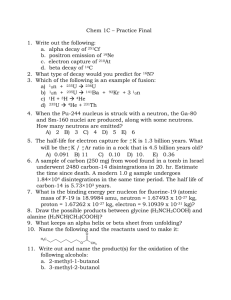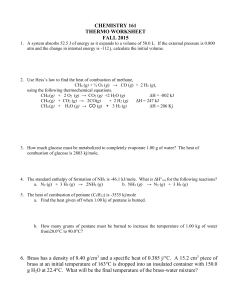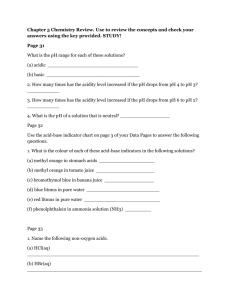Generation of protonic acid sites from pentane on the surfaces... Pt/SO -ZrO and Zn/H-ZSM5 evidenced by IR study of adsorbed pyridine
advertisement
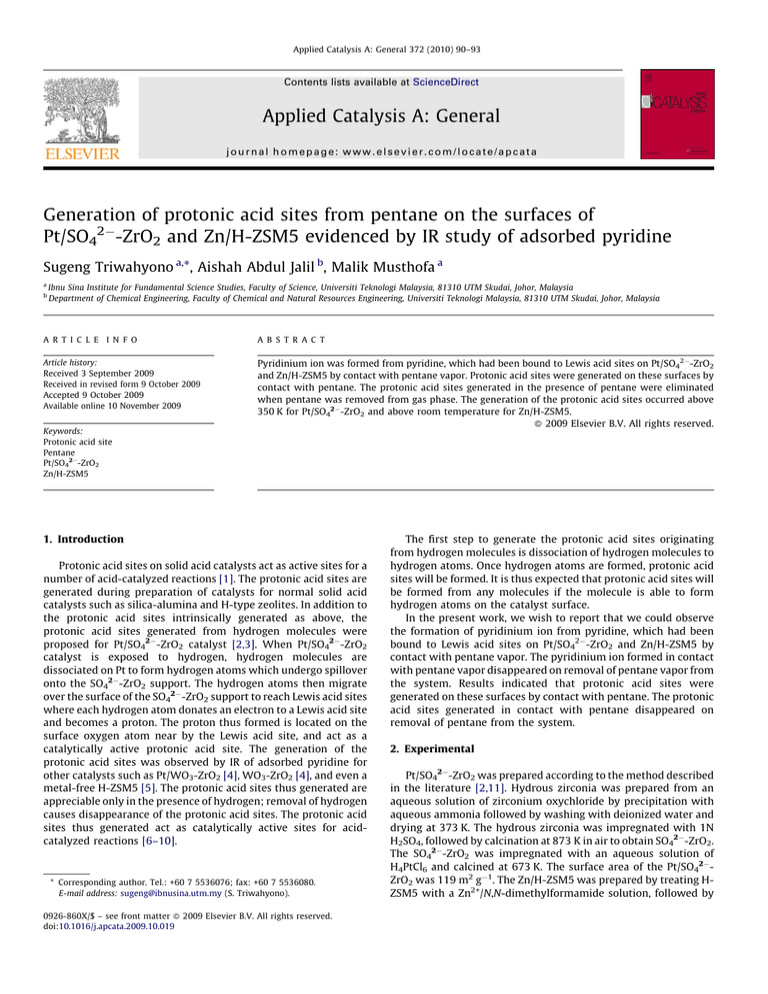
Applied Catalysis A: General 372 (2010) 90–93 Contents lists available at ScienceDirect Applied Catalysis A: General journal homepage: www.elsevier.com/locate/apcata Generation of protonic acid sites from pentane on the surfaces of Pt/SO42 -ZrO2 and Zn/H-ZSM5 evidenced by IR study of adsorbed pyridine Sugeng Triwahyono a,*, Aishah Abdul Jalil b, Malik Musthofa a a b Ibnu Sina Institute for Fundamental Science Studies, Faculty of Science, Universiti Teknologi Malaysia, 81310 UTM Skudai, Johor, Malaysia Department of Chemical Engineering, Faculty of Chemical and Natural Resources Engineering, Universiti Teknologi Malaysia, 81310 UTM Skudai, Johor, Malaysia A R T I C L E I N F O A B S T R A C T Article history: Received 3 September 2009 Received in revised form 9 October 2009 Accepted 9 October 2009 Available online 10 November 2009 Pyridinium ion was formed from pyridine, which had been bound to Lewis acid sites on Pt/SO42 -ZrO2 and Zn/H-ZSM5 by contact with pentane vapor. Protonic acid sites were generated on these surfaces by contact with pentane. The protonic acid sites generated in the presence of pentane were eliminated when pentane was removed from gas phase. The generation of the protonic acid sites occurred above 350 K for Pt/SO42 -ZrO2 and above room temperature for Zn/H-ZSM5. ß 2009 Elsevier B.V. All rights reserved. Keywords: Protonic acid site Pentane Pt/SO42 -ZrO2 Zn/H-ZSM5 1. Introduction Protonic acid sites on solid acid catalysts act as active sites for a number of acid-catalyzed reactions [1]. The protonic acid sites are generated during preparation of catalysts for normal solid acid catalysts such as silica-alumina and H-type zeolites. In addition to the protonic acid sites intrinsically generated as above, the protonic acid sites generated from hydrogen molecules were proposed for Pt/SO42 -ZrO2 catalyst [2,3]. When Pt/SO42 -ZrO2 catalyst is exposed to hydrogen, hydrogen molecules are dissociated on Pt to form hydrogen atoms which undergo spillover onto the SO42 -ZrO2 support. The hydrogen atoms then migrate over the surface of the SO42 -ZrO2 support to reach Lewis acid sites where each hydrogen atom donates an electron to a Lewis acid site and becomes a proton. The proton thus formed is located on the surface oxygen atom near by the Lewis acid site, and act as a catalytically active protonic acid site. The generation of the protonic acid sites was observed by IR of adsorbed pyridine for other catalysts such as Pt/WO3-ZrO2 [4], WO3-ZrO2 [4], and even a metal-free H-ZSM5 [5]. The protonic acid sites thus generated are appreciable only in the presence of hydrogen; removal of hydrogen causes disappearance of the protonic acid sites. The protonic acid sites thus generated act as catalytically active sites for acidcatalyzed reactions [6–10]. * Corresponding author. Tel.: +60 7 5536076; fax: +60 7 5536080. E-mail address: sugeng@ibnusina.utm.my (S. Triwahyono). 0926-860X/$ – see front matter ß 2009 Elsevier B.V. All rights reserved. doi:10.1016/j.apcata.2009.10.019 The first step to generate the protonic acid sites originating from hydrogen molecules is dissociation of hydrogen molecules to hydrogen atoms. Once hydrogen atoms are formed, protonic acid sites will be formed. It is thus expected that protonic acid sites will be formed from any molecules if the molecule is able to form hydrogen atoms on the catalyst surface. In the present work, we wish to report that we could observe the formation of pyridinium ion from pyridine, which had been bound to Lewis acid sites on Pt/SO42 -ZrO2 and Zn/H-ZSM5 by contact with pentane vapor. The pyridinium ion formed in contact with pentane vapor disappeared on removal of pentane vapor from the system. Results indicated that protonic acid sites were generated on these surfaces by contact with pentane. The protonic acid sites generated in contact with pentane disappeared on removal of pentane from the system. 2. Experimental Pt/SO42 -ZrO2 was prepared according to the method described in the literature [2,11]. Hydrous zirconia was prepared from an aqueous solution of zirconium oxychloride by precipitation with aqueous ammonia followed by washing with deionized water and drying at 373 K. The hydrous zirconia was impregnated with 1N H2SO4, followed by calcination at 873 K in air to obtain SO42 -ZrO2. The SO42 -ZrO2 was impregnated with an aqueous solution of H4PtCl6 and calcined at 673 K. The surface area of the Pt/SO42 ZrO2 was 119 m2 g 1. The Zn/H-ZSM5 was prepared by treating HZSM5 with a Zn2+/N,N-dimethylformamide solution, followed by S. Triwahyono et al. / Applied Catalysis A: General 372 (2010) 90–93 91 Each IR spectrum was measured in transmission mode with a sample prepared as a self-supported wafer. Prior to IR measurement, the sample was pre-treated with dried flowing nitrogen at 673 K for 3 h. Pyridine was adsorbed at 423 K for 30 min, followed by flushing with a nitrogen stream at 648 K for 30 min. Then, the sample was exposed to 5 kPa of pentane at room temperature and heated stepwise to 578 K. An IR spectrum was measured at every increment of temperature. The sample was then cooled to room temperature, and pentane was removed from the sample while increasing the temperature stepwise to 623 K in flowing nitrogen. 3. Results and discussion Fig. 1. IR spectra of pyridine adsorbed on Pt/SO42 -ZrO2. (A) Spectral changes when pyridine-preadsorbed sample was heated in pentane at (b) 373 K, (c) 393 K, (d) 423 K, (e) 473 K, (f) 528 K and (g) 573 K; (a) before exposure to pentane. (B) Spectral changes when the sample of the spectrum (g) was heated in a nitrogen flow at (h) 373 K, (i) 423 K, (j) 473 K, (k) 523 K and (l) 573 K. filtration, drying at 393 K and calcination at 873 K in air [12]. A commercial H-ZSM5 (Zeolyst) with Si/Al atomic ratio of 80 was used as a support catalyst. The H-ZSM5 contains protonic acid sites only after treatment at 773 K. The promotion of Zn decreased the protonic acid sites and generated Lewis acid sites. Zn2+/N,Ndimethylformamide solution was prepared following the procedure of Jalil et al. [12]. The surface area of the Zn/H-ZSM5 was 495 m2 g 1. The other catalysts examined included Pt/ZrO2, SO42 ZrO2 and H-ZSM5 catalysts. Pt/ZrO2 was prepared by impregnation of hydrous zirconia with an aqueous solution of H4PtCl6 and calcined at 673 K. The surface areas of Pt/ZrO2, SO42 -ZrO2 and HZSM5 catalysts were 44, 124 and 511 m2 g 1, respectively. Fig. 1 shows the changes of IR spectrum in the region 1600– 1400 cm 1 when the pyridine-preadsorbed Pt/SO42 -ZrO2 was heated in the presence of pentane vapor up to 578 K, followed by removal of pentane from the system with heating. The peak at 1455 cm 1 is ascribed to pyridine adsorbed on Lewis acid sites, and the peak at 1545 cm 1 is ascribed to pyridine adsorbed on protonic acid sites as pyridinium ions. Fig. 1A shows the spectra when pyridine-preadsorbed Pt/SO42 -ZrO2 was heated from 373 to 573 K in pentane. As the temperature was raised, the intensity of the peak at 1455 cm 1 decreased, with concomitant increase in the intensity of the peak at 1545 cm 1. Fig. 1B shows the spectra when the pentane was removed from the cell with increasing the temperature after the measurement of spectrum (g). As the temperature was raised, the intensity of the peak at 1545 cm 1 decreased, and the intensity of the peak at 1455 cm 1 increased almost to its original intensity. These results indicated that Lewis acid sites converted into protonic acid sites when the sample was heated in pentane, and the formed protonic acid sites were eliminated by removal of pentane with increasing the temperature, leading to restoration of the Lewis acid sites. These spectral changes would be more clearly shown if the fractions of protonic acid sites and Lewis acid sites are plotted against pentane exposure temperature and the temperature of heating in a nitrogen flow. For calculation of the fractions of acid sites, the value 2.7 for the ratio of the extinction coefficients at the bands 1455 and 1545 cm 1 was used. This ratio was obtained for Pt/SO42 -ZrO2 by converting the band at 1455 cm 1 to the band at 1545 cm 1 by introducing a small quantity of water. The ratio is sometimes under controversy, but the following observations show the reliability of this ratio at least in the present experiments, because the stoichiometric and reversible conversion between pyridine and pyridinium ion is estimated if one adopts this value. These plots are shown in Fig. 2A and B. The conversion of Lewis acid sites into protonic acid sites on heating in Fig. 2. The fraction of acid sites on Pt/SO42 -ZrO2 (A) after heating in the presence of pentane and (B) heating in a nitrogen flow at different temperatures. (*) Protonic acid site; (&) Lewis acid site; (*) protonic acid site and (&) Lewis acid site before exposure to pentane at room temperature. 92 S. Triwahyono et al. / Applied Catalysis A: General 372 (2010) 90–93 Fig. 3. IR spectra of pyridine adsorbed on Zn/H-ZSM5. (A) Spectral changes when pyridine-preadsorbed sample was heated in pentane at (b) room temperature, (c) 323 K, (d) 373 K, (e) 473 K and (f) 573 K; (a) before exposure to pentane. (B) Spectral changes when the sample of the spectrum (f) was heated in a nitrogen flow at (g) 323 K, (h) 373 K, (i) 473 K, (j) 573 K and (k) 623 K. the presence of pentane and the reversal process appear to occur at 350 K and above. The formation and elimination of the protonic acid sites in response to the presence and absence of pentane were also observed for Zn/H-ZSM5 (Fig. 3). The fractions of protonic acid sites and Lewis acid sites are plotted against pentane exposure temperature, and the temperature of heating in a nitrogen flow in Fig. 4. The fraction of acid sites for Zn/H-ZSM5 was calculated by use of the value 3.8 for the ratio of the extinction coefficients at the bands 1455 and 1545 cm 1. Fig. 3 shows the interconversion of protonic acid sites and Lewis acid sites in response to the presence and absence of pentane. The phenomena observed on Pt/SO42 ZrO2 and Zn/H-ZSM5 are essentially the same though there exist some differences between the two catalysts. The conversion began to occur at near room temperature and at 350 K for Zn/H-ZSM5 and Pt/SO42 -ZrO2, respectively. On the other hand, all the Lewis acid sites were converted to protonic acid sites at 573 K for Pt/SO42 ZrO2, while a part of Lewis acid sites still remained at 573 K for Zn/ H-ZSM5. The generation of protonic acid sites from pentane is essentially the same as the generation of protonic acid sites from molecular hydrogen. We propose that the generation of protonic acid sites is initiated by dissociation of pentane to form hydrogen atoms and pentyl radicals on the specific surface sites. The hydrogen atoms spillover onto the support surface and migrate over the support. When a hydrogen atom reaches a Lewis acid site, the hydrogen atom becomes a proton by donating an electron to the Lewis acid site. The proton thus formed is located on the surface oxygen atom near the Lewis acid site to generate a protonic acid site. It is plausible that the protonic acid sites thus generated act as catalytically active sites for acid-catalyzed reactions. We have examined several other catalysts for the generation of protonic acid sites from pentane molecules, but we could not observe the generation of protonic acid sites for Pt/ZrO2, SO42 ZrO2 and H-ZSM5. These results indicated that the presence of specific sites for dissociative-adsorption of hydrogen and the presence of Lewis acid sites to accept electrons from hydrogen atom are required. The experimental results strongly suggest that protonic acid sites are formed from pentane. Exactly speaking, what we observed was the transformation of pyridine to pyridinium ion in the presence of pentane. It has not been proven that a proton transfers via surface or directly from pentane molecule. However, the pyridinium ion formation was not observed for Pt free SO42 -ZrO2. If the proton transfer occurred directly from pentane molecule to the pyridine adsorbed on Lewis acid site, the formation of pyridinium ions on contact with pentane would occur on Pt free SO42 -ZrO2. Therefore, it is more plausible that the proton transfer occurs via the surface; protonic acid sites are formed from pentane molecules and the protonic acid sites donate protons to the pyridine molecules adsorbed on Lewis acid sites. The present IR study is the first report that demonstrates the generation of protonic acid sites from alkane molecules. Although we could observe the phenomenon for only two catalysts, the same phenomenon could occur on certain solid acid catalysts that are capable of dissociating alkane molecules to form hydrogen atoms. The protonic acid sites exist only in the presence of the alkanes, and disappear in the absence of alkanes. Accordingly, the protonic acid sites generated from alkane molecules should be taken into account in the reactions of alkanes. Fig. 4. The fraction of acid sites on Zn/H-ZSM5 (A) after heating in the presence of pentane and (B) heating in a nitrogen flow at different temperatures. (*) Protonic acid site; (&) Lewis acid site; (*) protonic acid site and (&) Lewis acid site before exposure to pentane at room temperature. S. Triwahyono et al. / Applied Catalysis A: General 372 (2010) 90–93 4. Conclusions The generation of protonic acid sites from pentane molecules was observed by IR study of adsorbed pyridine over the surfaces of Pt/SO42 -ZrO2 and Zn/H-ZSM5. The protonic acid sites are generated through dissociation of a pentane molecule to a hydrogen atom and a pentyl radical followed by spillover of the hydrogen atom onto the support and migration to reach Lewis acid site where the hydrogen atom donates an electron to Lewis acid site and becomes a proton. Acknowledgement This work was supported by an E-Science Fund Research Project No. 03-01-06-SF0020, The Ministry of Science, Technology and Innovation, Malaysia. 93 References [1] K. Tanabe, M. Misono, Y. Ono, H. Hattori, New Solid Acids and Bases, KodanshaElsevier, 1989. [2] K. Ebitani, J. Konishi, H. Hattori, J. Catal. 130 (1991) 257–267. [3] T. Shishido, H. Hattori, Appl. Catal. A: Gen. 146 (1996) 157–164. [4] S. Triwahyono, T. Yamada, H. Hattori, Appl. Catal. A: Gen. 242 (2003) 101–109. [5] K. Ebitani, J. Tsuji, H. Hattori, H. Kita, J. Catal. 138 (1992) 750–753. [6] T. Shishido, T. Nagase, K. Higo, J. Tsuji, H. Hattori, Stud. Surf. Sci. Catal. 101 (1996) 523–532. [7] T. Shishido, H. Hattori, J. Catal. 161 (1996) 194–197. [8] K. Tomishige, A. Okabe, K. Fujimoto, Appl. Catal. A: Gen. 194–195 (2000) 383– 393. [9] D.G. Barton, S.L. Soled, G.D. Meitzner, G.A. Fuentes, E. Iglesia, J. Catal. 181 (1999) 57–72. [10] M. Khurshid, M.A. Al-Daous, H. Hattori, S.S. Al-Khattaf, Appl. Catal. A: Gen. 362 (2009) 75–81. [11] T. Hosoi, T. Shimadzu, S. Ito, S. Baba, H. Takaoka, T. Imai, N. Yokoyama, Prepr. Am. Chem. Soc. Div. Pet. Chem. 33 (1988) 562–567. [12] A.A. Jalil, N. Kurono, M. Tokuda, Tetrahedron 58 (2002) 7477–7484.
